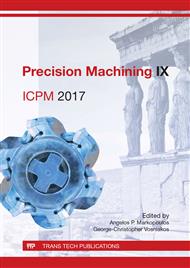p.3
p.9
p.17
p.22
p.28
p.36
p.44
p.50
Evaluation of Relationship between Cutting Parameters and Torque in Hole Making of Titanium Alloy
Abstract:
In terms of machinability are titanium alloys classified in the group of difficult to cut materials. The main factors determining this status are limited tool life, high generated cutting forces (torque) and temperature in cutting zone caused by low thermal conductivity as well as chemical reactivity with cutting tool. Solid carbide drills still remain as preferred choice in hole making process when machining Ti6Al4V alloy. Besides cutting conditions, tool and cutting edge geometry significantly affect the value of torque. Reduction of process energy requirements can be achieved by appropriate optimization of these parameters. Mathematical model describing influence of cutting speed, feed rate, clearance angle and cutting edge radius on investigated variable with high reliability coefficient (R2=96.72%) was found. Drilling experiments were designed and carried out using Taguchi orthogonal array L16.
Info:
Periodical:
Pages:
17-21
Citation:
Online since:
August 2017
Authors:
Keywords:
Price:
Сopyright:
© 2017 Trans Tech Publications Ltd. All Rights Reserved
Share:
Citation:


